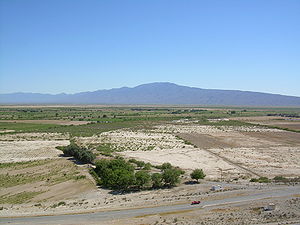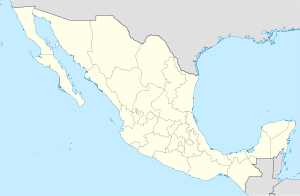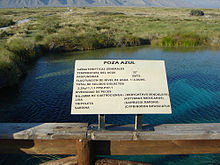- Cuatro Ciénegas
-
Cuatro Ciénegas de Carranza — City — Cuatrociénegas Valley Location in Mexico Coordinates: 26°59′10″N 102°3′59″W / 26.98611°N 102.06639°WCoordinates: 26°59′10″N 102°3′59″W / 26.98611°N 102.06639°W Country  Mexico
MexicoState Coahuila Municipality Cuatrociénegas Cuatro Ciénegas is a city in the northern Mexican state of Coahuila. It stands at 26°59′N 102°03′W / 26.983°N 102.05°W, at an average elevation of 740 metres above sea level. The city serves as the municipal seat for the surrounding municipality of the same name.
It is located in the state's desert region (Región Desierto). Cuatro Ciénegas is Spanish for "four marshes"; the name was chosen by the first settlers because of the natural springs in the vicinity that create extensive areas of wetland and lakes.
Several failed settlements were founded here prior to the successful establishment of a town by Antonio Cordero y Bustamante on 24 May 1800. The settlement's original name was Nuestra Señora de los Dolores y Cuatro Ciénegas, which was later changed to Villa Venustiano Carranza, before finally settling on its current name.
The city is formally known as Cuatro Ciénegas de Carranza, in honour of its most famous son: Venustiano Carranza, President of Mexico from 1915 to 1920, who was born there in 1859.
The municipality reported 12,154 inhabitants in the year 2000 census.
Contents
Cuatro Ciénegas Biosphere Reserve
Cuatro Ciénegas is an official Mexican biological reserve. The biological reserves are small ecosystems with unique fauna and flora that are highly protected by government authorities. Recently, NASA stated that the biological reserve of Cuatrociénegas could have strong links to discovering life on Mars, since the adaptability of bioforms in the region was unique in the world. There are some 150 different plants and animals endemic to the valley and its surrounding mountains (e.g., Fouquieria shrevei and Terrapene coahuila), including some 30 aquatic species in the Reserve, eight of which are fish (e.g., Herichthys minckleyi).
Live stromatolites inhabit Cuatro Ciénegas' pools. These are cyanobacteria colonies, extinct in most of the world, linked to the origin of an oxygen rich atmosphere over 3 billion years ago. A tiny copepod crustacean, Leptocaris stromatolicolus, is known only from the interstices of these stromatolites and bottom sediments in the saline pools.
The pools are an oligotrophic environment with little available phosphate,[1] leading one local bacterial species, Bacillus coahuilensis, to acquire the genes necessary to partially replace its membrane phospholipids with sulfolipids through horizontal gene transfer.[2]
Several environmental conservation leaders are working to protect the valley, including Pronatura Noreste. The organization owns a private reserve, called Pozas Azules, and has several ongoing projects that include the protection of native species, including stromatolites and the eradication of invasive flora and fauna, as well as community development and water efficient agriculture combined with organic techniques.
Drying out?
Scientists working in the basin and some local residents claim to have observed reduced spring discharge and a decrease in surface water in the Cuatro Ciénegas Basin (CCB) in recent years, although these changes have not been well documented in the scientific literature. Some have blamed the possible drying out on changes in climate and others have ascribed it to the introduction of large scale agriculture in adjacent valleys over the past two decades.
Valeria Souza, an ecology professor and researcher at the National Autonomous University of Mexico, found that based on genetic studies of microbes in the CCB and surrounding valleys, the aquifer extends far beyond the CCB and includes adjacent valleys.[3] She published her results in the Proceedings of the National Academy of Sciences in April 2006. Regarding the source of drying out, she wrote: "Similar to situations occurring with increasing frequency in various arid regions of the world, agricultural development and associated water extraction in the region have placed new pressures on the ecological integrity of the unique ecosystems of Cuatro Ciénegas."
Research by hydrogeologist Brad Wolaver at the University of Texas at Austin, now at Flinders University, also found evidence that the aquifer supplying the water that emerges at the surface of the Cuatro Ciénegas Basin extends far beyond the basin and thus is potentially impacted by agricultural water extraction in adjacent valleys.[4][5]
See also
References
- ^ Borrell, Brendan (2010-11-01). "Elemental Shortage". The Scientist 24 (11): 46. http://www.the-scientist.com/2010/11/1/46/1/. Retrieved 2010-11-09.
- ^ Alcaraz, Luis David; et al. (2008-04-11). "The genome of Bacillus coahuilensis reveals adaptations essential for survival in the relic of an ancient marine environment". Proceedings of the National Academy of Sciences (National Academy of Sciences) 105 (15): 5803–5808. doi:10.1073/pnas.0800981105. http://www.pnas.org/content/105/15/5803.short. Retrieved 2010-11-09.
- ^ Souza (2006) "An endangered oasis of aquatic microbial biodiversity in the Chihuahuan desert" http://www.pnas.org/content/103/17/6565.full.pdf
- ^ Wolaver (2008), "Hydrogeology of the Cuatrocienegas Basin, Coahuila, Mexico: An Integrative Approach to Arid Karst Aquifer Delineation" http://www.lib.utexas.edu/geo/thesis_dissertations/thesisabstracts2.html#wolaver
- ^ Wolaver (2008), "Delineation of Regional Arid Karstic Aquifers: An Integrative Data Approach" http://www3.interscience.wiley.com/cgi-bin/fulltext/119390551/PDFSTART
External links
- Cuatro Ciénagas: municipal webpage
- Cuatro Ciénagas: tourism and attractions
- Pronatura Noreste in the Chihuahuan Desert
- Cuatrociénagas, Desert Fishes Council
- Cuatrociénegas Scientific Research Center / Centro de Investigación Científica de Cuatrociénegas
Saltillo (capital)Topics Architecture · Climate · Culture · Demographics · Economy · Education · Geography · Government · History · Literature · Politics · Sports · Transportation · Tourist Attractions

Municipalities
and
(municipal seats)Abasolo (Abasolo) · Acuña (Ciudad Acuña) · Allende (Allende) · Arteaga (Arteaga) · Candela (Candela) · Castaños (Castaños) · Cuatrociénegas (Cuatrociénegas de Carranza) · Escobedo (Escobedo) · Francisco I. Madero (Francisco I. Madero) · Frontera (Ciudad Frontera) · General Cepeda (General Cepeda) · Guerrero (Guerrero) · Hidalgo (Hidalgo) · Jiménez (Jiménez) · Juárez (Juárez) · Lamadrid (Lamadrid) · Matamoros (Matamoros de la Laguna) · Monclova (Monclova) · Morelos (Morelos) · Múzquiz (Santa Rosa de Múzquiz) · Nadadores (Nadadores) · Nava (Nava) · Ocampo (Ocampo) · Parras (Parras de la Fuente) · Piedras Negras (Piedras Negras) · Progreso (Progreso) · Ramos Arizpe (Ramos Arizpe) · Sabinas (Sabinas) · Sacramento (Sacramento) · Saltillo (Saltillo) · San Buenaventura (San Buenaventura) · San Juan de Sabinas (Nueva Rosita) · San Pedro de las Colonias (San Pedro de las Colonias) · Sierra Mojada (Sierra Mojada) · Torreón (Torreón) · Viesca (Viesca) · Villa Unión (Villa Unión) · Zaragoza (Zaragoza)
Categories:- Populated places in Coahuila
- Chihuahuan Desert
- Biosphere reserves of Mexico
- Deserts of Mexico
Wikimedia Foundation. 2010.



